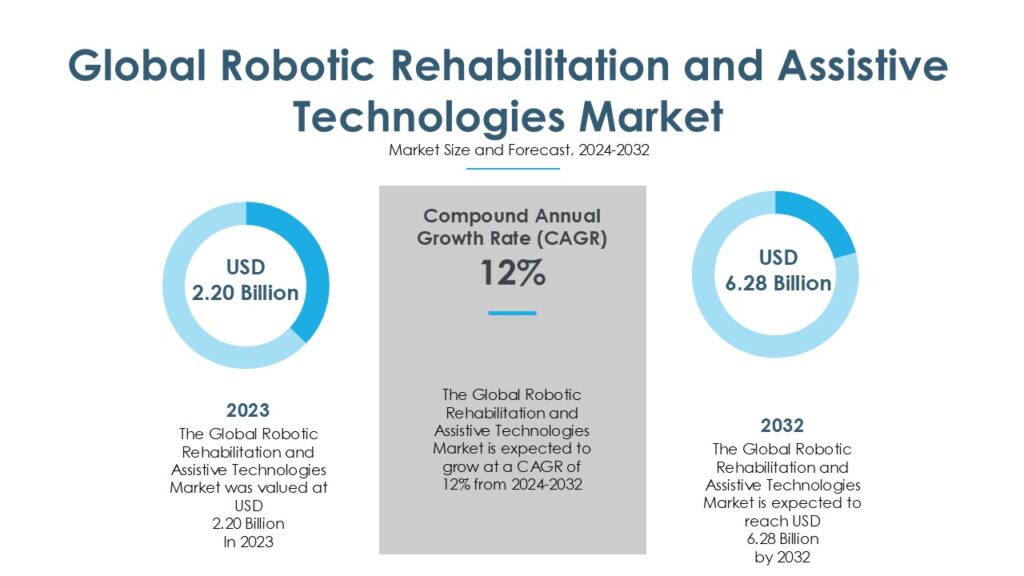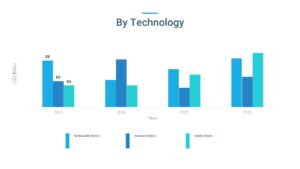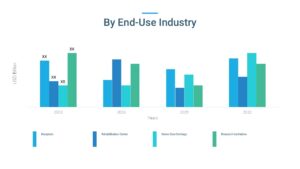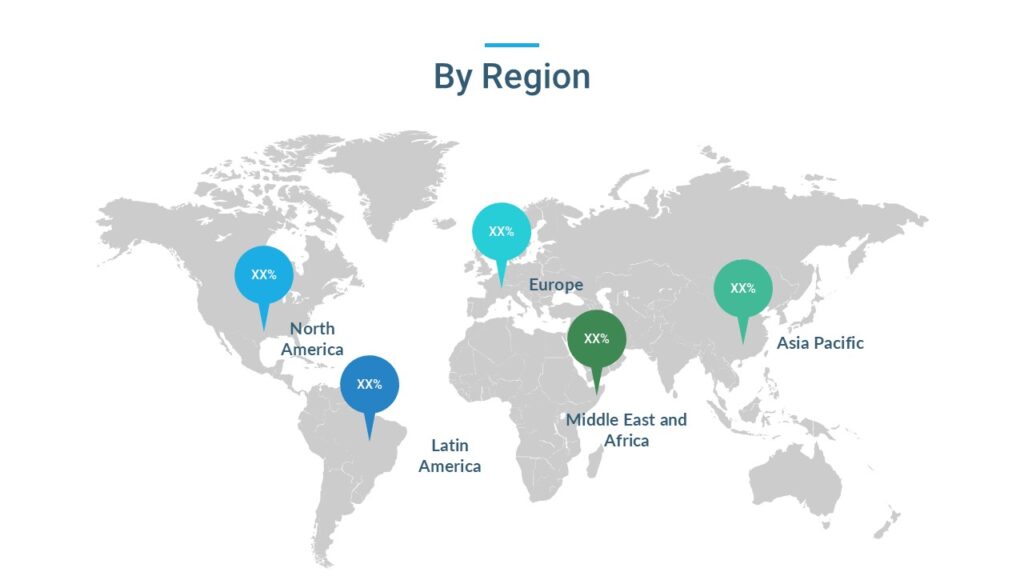
Global Robotic Rehabilitation and Assistive Technologies Market "(By Product Type: Rehabilitation Robots, Assistive Robots, Therapeutic Robots; By Technology: Wearable Robots, Stationary Robots, Mobile Robots, By Application: Stroke Rehabilitation, Orthopedic Rehabilitation, Neurorehabilitation; By End-Use Industry: Hospitals, Rehabilitation Centers, Home Care Settings, Research Institution; By Region: North America, Europe, Asia Pacific, Latin America, and Middle East and Africa)”- Global Industry Analysis, Size, Share, Growth, Trends, And Forecast, 2024-2032
- Category: Medical Devices and Diagnostics
- Report ID: CMR34039
- Published Date:
A prominent research firm, Cognizance Market Research added a cutting-edge industry report on the “Global Robotic Rehabilitation and Assistive Technologies Market”. The report studies the current and past growth trends and opportunities for the market to gain valuable insights during the forecast period from 2023 to 2032.
Global Robotic Rehabilitation and Assistive Technologies Market Analysis:
According to cognizance market research, the Global Robotic Rehabilitation and Assistive Technologies market was valued at US$ 2.20 Billion in 2023 and is anticipated to reach US$ 6.28 Billion by the end of 2032 with a CAGR of 12% from 2023 to 2032.

What is the Global Robotic Rehabilitation and Assistive Technologies Market?
The global robotic rehabilitation and assistive technologies market involves the robotic systems and devices used for therapy, rehabilitation, and assistance care for the disabled, injured, and patients with other chronic diseases. These technologies integrate the concepts of robots, AI, and sensors to facilitate recovery and enhance mobility and overall functional status for a better quality of life.
This market comprises robotic exoskeletons and assistive robotic arms employed in hospitals and rehabilitation and home care facilities, as well as therapeutic robots. These devices are designed with the particular end user needs in mind, used for stroke rehabilitation, neuro therapy, and mobility requirements, and thus provide a wide variety of solutions.
It is stimulated by factors such as an increase in cases of chronic diseases, enhanced demographic aging, and the growing demand for sophisticated healthcare services. They include future development of AI; increasing investment in healthcare robotics; and changing trends toward home-based care that also contribute to the development of this sector.
Among all over the world, North America has the most market share due to the most developed healthcare and technology, however, regions of Asia-Pacific are swiftly growing by the increasing investment and healthcare conscious. It also remains apparent that the need for cost-efficient and innovative solutions that meet the needs of patients is going to remain strong.
Global Robotic Rehabilitation and Assistive Technologies Market Outlook:
The global market for robotic rehabilitation and assistive technologies is expected to experience high growth in demand due to the rising incidence of neurological diseases, orthopedic abnormalities, and other chronic diseases. Eldercare around the world also indicates growing longevity demanding improvements that would help increase mobility and quality of life.
The utilization of AI and ML in the market capital has greatly increased through technological developments. The aforementioned technologies allow robotic systems to administer therapy, track the patient’s developments, and adjust the therapy consistent with specific patient requirements, making therapeutic interventions much more effective than conventional methods.
One of the most important trends is the tendency toward home-based care. Advanced and easy-to-carry devices enable patients to proceed with their therapies from the comfort of their homes thus relieving the burden from clinical appointments and concomitantly cutting down healthcare costs. This trend is in line with a recent expansion of telepractice as well as other remote-based healthcare activities.
North America is the largest market for integrated operating rooms due to the well-developed healthcare, a high level of technology usage, and effective reimbursement systems. Europe comes next with the backing of strong healthcare industries and effective legislation, meanwhile, Asia-Pacific remains a rapidly growing market as investment and consciousness grow.
Market limitations are mainly the high costs of robotic systems and poor availability, particularly in developing countries. Nonetheless, these challenges have been covered by improving government support in funding and joint approaches involving the main stakeholders.
The market outlook is further strong because recent R&D initiatives are unveiling new products. So robotic rehabilitation and assistive technologies are promising instruments, that can provide an opportunity for human sufferers to forget about various mobility issues and improve the quality of life, and it will become one of the trends in the further development of healthcare.
Segment Analysis:
The market is divided based on types of products, applications, end-users, technology, and regions. As for the product segment, rehabilitation robots reign, as the applications targeting stroke, neurological disorders, and physical therapy are among them. Robotic systems for assistive support like exoskeletons and robotic arms are proving useful because of the improvements to Quality of Life they bring. Another very large segment is therapeutic robots intended for specific exercises.


Based on application, there is a high demand for stroke rehabilitation, as the largest share that d also is having at present, gait training, and neurorehabilitation are experiencing the highest level of growth. The end-users are the hospitals, rehabilitation centers, and home care settings in which the hospitals have taken the lead. On the other hand, the home care segment is gradually growing because of shifting customer trends towards convenience and lightweight products. Currently, wearable robotics and stationary systems stand as the most prevalent market sectors; however, mobile robots are a new and promising market segment.


Geographical Analysis:
The three largest regions in terms of market share include North America due to the enhanced healthcare infrastructure, increased uptake of advanced new technologies, and sound reimbursement policies. Out of the countries of the region, the United States has the most share due to high investments in research and development, and the increased demand for effective rehabilitation and assistive technologies. Integrated relationships between healthcare organizations, university institutions, and technology also enhance fast expansion in this area.
Europe stands second largest market followed by Germany, France, and the United Kingdom in this regard. The region has favorable healthcare infrastructure, an enabling environment for healthcare innovation, and a growing appreciation of robotic rehabilitation solutions. In the European region, two-thirds of the population is over sixty years hence; increasing lifespans together with rising awareness of the need to enhance mobility also fuel usage.
The Asia-Pacific region is the most rapidly expanding market due to the growing procurement of healthcare facility services and the enhanced use of more advanced healthcare technology. During the Asia-Pacific region, China, Japan, and South Korea’s manufacturing economies and growing healthcare industry demand medical devices. Also, an increasing incidence of chronic diseases and a shift towards individual-centered medicine create market demand. Asian emerging markets including those in South East Asia are also promising due to enhancements in the healthcare sector literacy.

This report provides the Global Robotic Rehabilitation and Assistive Technologies Market size for the years 2020 to 2032 by taking into consideration 2018 to 2020 as the historical year, 2021 as the base year, and 2022 to 2032 as a forecasted year. This report also offers the compound annual growth rate (CAGR) of the Global Robotic Rehabilitation and Assistive Technologies Market for the period of the forecast. The Global Robotic Rehabilitation and Assistive Technologies Market research study assesses and identifies key trends affecting businesses and corporations in the worldwide location. The Global Robotic Rehabilitation and Assistive Technologies Market revenue has been analyzed by expressing it as a percentage of different segments, and the report comprises a comprehensive outline of the factors fueling the Global Robotic Rehabilitation and Assistive Technologies Market’s revenue growth.
This report primarily has been written based on secondary and primary research only. Sources for secondary research included internet sources, numerical data from the government, trade associations, and websites. Scholars have also used a combination of bottom-up and top-down analysis methodologies to research many aspects of the Global Robotic Rehabilitation and Assistive Technologies Market. In secondary research, more focus was paid on understanding the portfolio of products offered by major stakeholders. Analyzing the trade journals, Research articles, company reports, newspapers, and magazines, White papers, and other relevant documents have also been used to understood Global Robotic Rehabilitation and Assistive Technologies Market. Quantitative research included, a significant degree of research and development activity in which professionals engage industry veterans telephonic and questioner-based interviews.
The report comprises an executive summary; besides this, the document has a growth pattern of various segments that are part of the scope of the research. The Y-o-Y analysis with the detailed market overview has been discussed in the report to understand the Y-o-Y growth trends present in the Global Robotic Rehabilitation and Assistive Technologies Market. Also, the report is directed at changing the competitive positioning of the companies in the global market. The above indices are precious for present market participants, as well as for those firms who are willing to enter the sphere of the Global Robotic Rehabilitation and Assistive Technologies Market. The subsequent section of the Global Robotic Rehabilitation and Assistive Technologies Market report uses the USPs including key industry events such as new product launches, research collaborations, acquisitions, and so on; technology innovations; pipeline and prevalence data; and regulatory reformation.
Global Robotic Rehabilitation and Assistive Technologies Market Competitive Landscape:
There are several small and major firms participating in the highly fragmented Global Robotic Rehabilitation and Assistive Technologies Market. The new strategies formed by companies revolve around accuracy and precision. The following are some of the major market participants:
- Hocoma AG
- Ekso Bionics Holding Inc.
- ReWalk Robotic Ltd
- Bionik Laboratories Corporation
- Cyberdyne Inc.
- Parker Hannifin Corporation
- AlterG Inc.
- Medtronic Inc.
- Kinova Robotics
- Instead Technologies Ltd
- Rex Bionic Ltd
- Fourier Intelligence
The report explores the competitive scenario of the Global Robotic Rehabilitation and Assistive Technologies Market. Major players working in the Global Robotic Rehabilitation and Assistive Technologies Market have been named and profiled for their unique commercial attributes. Company overview (company description, product portfolio, geographic presence, employee strength, Key management, etc.), financials, SWOT analysis, recent developments, and key strategies are some of the features of companies profiled in the Global Robotic Rehabilitation and Assistive Technologies Market report.
Segmentation:
Global Robotic Rehabilitation and Assistive Technologies Market, By Product Type:
- Rehabilitation Robots
- Assistive Robots
- Therapeutic Robots
Global Robotic Rehabilitation and Assistive Technologies Market: By Technology
- Wearable Robots
- Stationary Robots
- Mobile Robots
Global Robotic Rehabilitation and Assistive Technologies Market, By End-use Industry:
- Hospitals
- Rehabilitation Centers
- Home Care Settings
- Research Institution
Global Robotic Rehabilitation and Assistive Technologies Market, By Application:
- Stroke Rehabilitation
- Orthopedic Rehabilitation
- Neurorehabilitation
Global Robotic Rehabilitation and Assistive Technologies Market, by Region:
- North America
- U.S.
- Canada
- Europe
- Germany
- U.K.
- France
- Spain
- Italy
- Rest of Europe
- Asia Pacific
- Japan
- China
- India
- Australia & New Zealand
- South Korea
- Rest of Asia Pacific
- Latin America
- Brazil
- Mexico
- Rest of Latin America
- Middle East & Africa
- GCC
- South Africa
- Rest of the Middle East & Africa
Research Methodology: Aspects
Market research is a crucial tool for organizations aiming to navigate the dynamic landscape of customer preferences, business trends, and competitive landscapes. At Cognizance Market Research, acknowledging the importance of robust research methodologies is vital to delivering actionable insights to our clientele. The significance of such methodologies lies in their capability to offer clarity in complexity, guiding strategic management with realistic evidence rather than speculation. Our clientele seek insights that excel superficial observations, reaching deep into the details of consumer behaviours, market dynamics, and evolving opportunities. These insights serve as the basis upon which businesses craft tailored approaches, optimize product offerings, and gain a competitive edge in an ever-growing marketplace.
The frequency of information updates is a cornerstone of our commitment to providing timely, relevant, and accurate insights. Cognizance Market Research adheres to a rigorous schedule of data collection, analysis, and distribution to ensure that our reports reflect the most current market realities. This proactive approach enables our clients to stay ahead of the curve, capitalize on emerging trends, and mitigate risks associated with outdated information.
Our research process is characterized by meticulous attention to detail and methodological rigor. It begins with a comprehensive understanding of client objectives, industry dynamics, and research scope. Leveraging a combination of primary and secondary research methodologies, we gather data from diverse sources including surveys, interviews, industry reports, and proprietary databases. Rigorous data analysis techniques are then employed to derive meaningful insights, identify patterns, and uncover actionable recommendations. Throughout the process, we remain vigilant in upholding the highest standards of data integrity, ensuring that our findings are robust, reliable, and actionable.
Key phases involved in in our research process are mentioned below:

Understanding Clients’ Objectives:
Extensive Discussions and Consultations:
- We initiate in-depth discussions and consultations with our clients to gain a comprehensive understanding of their objectives. This involves actively listening to their needs, concerns, and aspirations regarding the research project.
- Through these interactions, we aim to uncover the underlying motivations driving their research requirements and the specific outcomes they hope to achieve.
Industry and Market Segment Analysis:
- We invest time and effort in comprehensively understanding our clients’ industry and market segment. This involves conducting thorough research into market trends, competitive dynamics, regulatory frameworks, and emerging opportunities or threats.
- By acquiring a deep understanding of the broader industry landscape, we can provide context-rich insights that resonate with our clients’ strategic objectives.
Target Audience Understanding:
- We analyze our clients’ target audience demographics, behaviors, preferences, and needs to align our research efforts with their consumer-centric objectives. This entails segmenting the audience based on various criteria such as age, gender, income level, geographic location, and psychographic factors.
- By understanding the nuances of the target audience, we can tailor our research methodologies to gather relevant data that illuminates consumer perceptions, attitudes, and purchase intent.

Identifying Challenges and Opportunities:
- We proactively identify the challenges and opportunities facing our clients within their respective industries. This involves conducting SWOT (Strengths, Weaknesses, Opportunities, Threats) analyses and competitive benchmarking exercises.
- By identifying potential obstacles and growth drivers, we can provide strategic recommendations that help our clients navigate complexities and capitalize on emerging opportunities effectively.
Grasping Specific Goals:
- We delve into the intricacies of our clients’ objectives to gain clarity on the specific goals they aim to accomplish through the research. This entails understanding their desired outcomes, such as market expansion, product development, or competitive analysis.
- By gaining a nuanced understanding of our clients’ goals, we can tailor our research approach to address their unique challenges and opportunities effectively.
Data Collection:

Primary Research Process:
- Surveys: We design and administer surveys tailored to capture specific information relevant to our clients’ objectives. This may involve employing various survey methodologies, such as online, telephone, or face-to-face interviews, to reach target audiences effectively.
- Interviews: We conduct structured or semi-structured interviews with key stakeholders, industry experts, or target consumers to gather in-depth insights and perspectives on relevant topics. These interviews allow us to probe deeper into specific issues and uncover valuable qualitative data.
- Focus Groups: We organize focus group discussions with carefully selected participants to facilitate interactive discussions and gather collective opinions, attitudes, and preferences. This qualitative research method provides rich contextual insights into consumer behaviors and perceptions.
- Observations: We conduct observational research by directly observing consumer behaviors, interactions, and experiences in real-world settings. This method enables us to gather objective data on consumer actions and reactions without relying on self-reported information.
Secondary Research Process:
- Literature Review: We conduct comprehensive literature reviews to identify existing studies, academic articles, and industry reports relevant to the research topic. This helps us gain insights into previous research findings, theoretical frameworks, and best practices.
- Industry Reports: We analyze industry reports published by reputable trade associations (whitepapers, research studies, etc.), and government agencies (U.S. Census Bureau, Bureau of Labor Statistics, and Securities and Exchange Commission etc.) to obtain macro-level insights into market trends, competitive landscapes, and industry dynamics.
- Government Publications: We review government publications, such as economic reports, regulatory documents, and statistical databases, to gather relevant data on demographics, market size, consumer spending patterns, and regulatory frameworks.
- Online Databases: We leverage online databases, such as industry portals, and academic repositories (PubMed Central (PMC), ScienceDirect, SSRN (Social Science Research Network), Directory of Open Access Journals (DOAJ), NCBI, etc.), to access a wide range of secondary data sources, including market statistics, financial data, and industry analyses.


Data Analysis:
The data analysis phase serves as a critical juncture where raw data is transformed into actionable insights that inform strategic decision-making. Through the utilization of analytical methods such as statistical analysis and qualitative techniques like thematic coding, we uncover patterns, correlations, and trends within the data. By ensuring the integrity and validity of our findings, we strive to provide clients with accurate and reliable insights that accurately reflect the realities of the market landscape.

Transformation of Raw Data:
- Upon collecting the necessary data, we transition into the data analysis phase, where raw data is processed and transformed into actionable insights. This involves organizing, cleaning, and structuring the data to prepare it for analysis.
Utilization of Analytical Methods:
- Depending on the research objectives, we employ a diverse range of analytical methods to extract meaningful insights from the data. These methods include statistical analysis, trend analysis, regression analysis, and qualitative coding.
Statistical Analysis:
- Statistical tools are instrumental in uncovering patterns, correlations, and trends within the data. By applying statistical techniques such as descriptive statistics, hypothesis testing, and multivariate analysis, we can discern relationships and derive valuable insights.
Qualitative Analysis Techniques:
- In addition to quantitative analysis, we leverage qualitative analysis techniques to gain deeper insights from qualitative data sources such as interviews or open-ended survey responses. One such technique is thematic coding, which involves systematically categorizing and interpreting themes or patterns within qualitative data.
Integrity and Validity Maintenance:
- Throughout the analysis process, we maintain a steadfast commitment to upholding the integrity and validity of our findings. This entails rigorous adherence to established methodologies, transparency in data handling, and thorough validation of analytical outcomes.
Data Validation:
The final phase of our research methodology is data validation, which is essential for ensuring the reliability and credibility of our findings. Validation involves scrutinizing the collected data to identify any inconsistencies, errors, or biases that may have crept in during the research process. We employ various validation techniques, including cross-referencing data from multiple sources, conducting validity checks on survey instruments, and seeking feedback from independent experts or peer reviewers. Additionally, we leverage internal quality assurance protocols to verify the accuracy and integrity of our analysis. By subjecting our findings to rigorous validation procedures, we instill confidence in our clients that the insights they receive are robust, reliable, and trustworthy.

Importance of Data Validation:
- Data validation is the final phase of the research methodology, crucial for ensuring the reliability and credibility of the findings. It involves a systematic process of reviewing and verifying the collected data to detect any inconsistencies, errors, or biases.
Scrutiny of Collected Data:
- The validation process begins with a thorough scrutiny of the collected data to identify any discrepancies or anomalies. This entails comparing data points, checking for outliers, and verifying the accuracy of data entries against the original sources.
Validation Techniques:
- Various validation techniques are employed to ensure the accuracy and integrity of the data. These include cross-referencing data from multiple sources to corroborate findings, conducting validity checks on survey instruments to assess the reliability of responses, and seeking feedback from independent experts or peer reviewers to validate the interpretation of results.
Internal Quality Assurance Protocols:
- In addition to external validation measures, internal quality assurance protocols are implemented to further validate the accuracy of the analysis. This may involve conducting internal audits, peer reviews, or data validation checks to ensure that the research process adheres to established standards and guidelines.
Report Scope:
Attribute
Description
Market Size
US$ 6.28 Billion (2032)
Compound Annual Growth Rate (CAGR)
12%
Base Year
2023
Forecast Period
2024-2032
Forecast Units
Value (US$ Billion)
Report Coverage
Revenue Forecast, Competitive Landscape, Growth Factors, and Trends
Geographies Covered
North America, Europe, Asia Pacific, Latin America, Middle East & Africa
Countries Covered
U.S., Canada, Germany, U.K., France, Spain, Italy, Rest of Europe, Japan, China, India, Australia & New Zealand, South Korea, Rest of Asia Pacific, Brazil, Mexico, Rest of Latin America, GCC, South Africa, Rest of Middle East & Africa
Key Companies Profiled
Hocoma AG, Ekso Bionics Holding Inc., ReWalk Robotic Ltd, Bionik Laboratories Corporation, Cyberdyne Inc., Parker Hannifin Corporation, AlterG Inc., Medtronic Inc., Kinova Robotics, Instead Technologies Ltd, Rex Bionic Ltd, and Fourier Intelligence
Key Questions Answered in Robotic Rehabilitation and Assistive Technologies Market Report
How big was the Global Robotic Rehabilitation and Assistive Technologies Market in 2023?
It was Valued at US$ 2.20 Billion in 2023.
How big will be the industry size in 2032?
It is projected to reach more than US$ 6.28 Billion by 2032.
What will be the CAGR during the forecast period?
It is anticipated to be 12% from 2024 to 2032.
What are the trends, drivers, opportunities, and challenges in the Global Robotic Rehabilitation and Assistive Technologies Market?
Trend: Enhanced employment of artificial intelligence and machine learning as key elements in delivering confident and effective therapy with linkages to better rehabilitation results.
Driver: The increase in the number of elderly people and the increase in cases of chronic diseases as the reasons for the need for assistive technologies.
Opportunities: Availability of affordable and highly transportable units that will be more advisable for homemade use with a wider population base.
Challenges: This is mainly due to the situation that the high initial costs of robotic rehabilitation systems somewhat restrain further applications.
What are the major players operating in the Global Robotic Rehabilitation and Assistive Technologies Market?
Hocoma AG, Ekso Bionics Holding Inc., ReWalk Robotic Ltd, Bionik Laboratories Corporation, Cyberdyne Inc., Parker Hannifin Corporation, AlterG Inc., Medtronic Inc., Kinova Robotics, Instead Technologies Ltd, Rex Bionic Ltd, and Fourier Intelligence.
We can customize every report – free of charge – including purchasing stand-alone sections or country-level reports
We help clients to procure the report or sections of the report at their budgeted price. Kindly click on the below to avail



